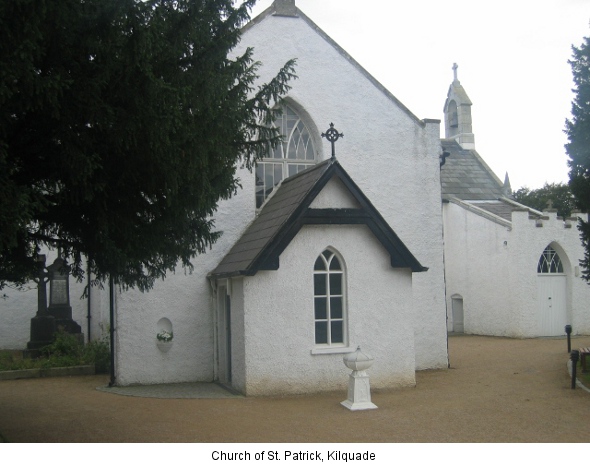Journal Volume 6 2010
A Greystones Miscellany (continued/5)
Church of St. Patrick, Kilquade: Parish Priests of the 19th Century
By Leo Ireton
In 2002 the parish of Kilquade celebrated the 200th anniversary of the building of the Church of St Patrick. The Parish Priest at the time of the Church’s building in 1802 was the Rev. William O’Neill. Born near Rathdrum in 1744, ‘for 38 years he filled the Important and arduous situation [an allusion to the 1798 Rebellion] of Roman Catholic Pastor of the United Parishes of Kilquade and Kilmurray’. He died in 1822 and is buried in Kilquade. Father William O’Neill was succeeded as Parish Priest of Kilquade by the Rev. Alexander Roche in July 1822. Father Roche was appointed Parish Priest of Bray in July 1826 and was followed in the post of Parish Priest of Kilquade by Father Stennett.
Charles Stennett was born in 1783 and went to school at Stonyhurst, England. He gained a commission in the King’s Army and fought in the Napoleonic Wars. He married and had an only daughter, Mary Weld Stennett. His wife dying, he resigned his commission and went to study for the priesthood. He was ordained in 1814. From 1815 to 1824 Father Stennett was C.C. in St. Audoen’s Church, Dublin City. He was appointed Parish Priest of Donabate, North Dublin, in 1824, and then in 1826 appointed Parish Priest of Kilquade.
Father Stennett proved to be a man of ability and knew his own mind. Nor did the Law Courts frighten him: on one particular occasion the bone of contention being a fight over schools. He was a daring horseman and donned a British officer’s uniform more than once and rode out and took over command of the ‘running raving wild astonished soldiery’ believing, it would seem, that he had no chance donned as a priest. As a known priest he is said to have been fired on more than once.
The Catholic community in area was an active one: after Catholic Emancipation in 1829 Daniel O’Connell wrote to Father Stennett asking if he had received a receipt for the contribution made by the parishioners of St. Patrick’s to the newly formed Catholic Association.
His daughter Mary kept house for him at Birch Ville, the parish priest’s house at that time. She married Henry M Redmond at Kilquade on 10th February 1840. The marriage ceremony was performed by Rev. A O’Connell, Parish Priest of St Michael and John’s, Dublin, and particulars of the wedding are recorded in the Kilquade Parish Marriage Register in Father Stennett’s own hand. They resided at Birch Ville.
Father Stennett, whose health had been failing, advised his daughter to see to the renewal of the lease on Birch Ville but before anything was done about it Father Stennett himself expired on 25th December 1840. He was buried at Kilquade. On entering the Church of St Patrick there is a memorial on the wall to the right which reads:
‘Monument erected by Henry M Redmond of Birch Ville, Esq., in memory of the Revd. Charles Barker Stennett, P.P. of Kilquade and Kilmurray and Prebend of Kilmactalway [near Clondalkin, Co. Dublin], who departed this life on the 25th December 1840 in the 57th year of his age and 16th [should be 15th] of his ministry in the above Parishes.’
‘I have fought a good fight. I have finished my course. I have kept the faith.
R.I.P.’
Henry Redmond and his wife Mary afterwards lived at Popefield House, Athy, Co. Kildare. Their first son, Charles Stennett Redmond, was born in 1843 and was educated in Trinity College and London University. He became a medical practitioner. His son Charles Henry Redmond, 1882 – 1966, married three times and had seven children.
Father Stennett was succeeded by the Rev. Matthew Fagan in 1842. During his time in Kilquade the Convent of Carmelite Nuns was founded. Briefly this came about in the following way:-
The Chaplain of the Warrenmount Carmelite Convent in Dublin fell ill during Holy Week. Father Fagan, on a visit to Dublin, volunteered to do the Chaplain’s work for a week and it was during this time that he mentioned to the Prioress his wish to have a Carmelite Convent in the Parish of Kilquade. A charitable lady, Mrs. Delahoyde, having heard of the proposal, donated £600.
Out one day on horseback, he met with Mr Peter Murray: ‘Will this house do?’ asked Mr Murray, ‘if so I will sell it to the nuns for the same as I paid for it, £400; and the land for the same rent as myself.’ The kind offer was accepted and the generous donation of Mrs. Delahoyde paid for the house and for some necessary furniture. The house was occupied by four nuns and two postulants who arrived in Delgany on the 7th December 1844.
Father Fagan was Parish Priest of Kilquade for 21 years and died in 1863 in his 75th year. He was succeeded by the Rev. Peter Segrave who had been A.D.M. for a year or two during the failing health of Father Fagan. Father Segrave was a priest of the parish for 46 years, 30 of them as Parish Priest. He, with the parishioners, built the present Church of St. Joseph in Newtownmountkennedy at a cost of £1,300, construction of which started in the year 1864 with voluntary workers.
The Rev. James Walsh was appointed A.D.M. to aid Father Segrave in his latter years and he became Parish Priest on Father Segrave’s death on 4th May 1891. During Father Walsh’s time in Kilquade two Convents and Schools of the Sisters of Holy Faith were founded: the one at Kilcoole and the other at Trudder (near Newtown). Father Walsh died in 1901 and was buried in Kilquade.

Sources
[1] A Garden and a Grave Kilquade, by Rev. John Masterson P.P.
[2] Private correspondence from Dr. Shelagh Mary Stennett Redmond, great granddaughter of Henry Remond and Mary Weld.


